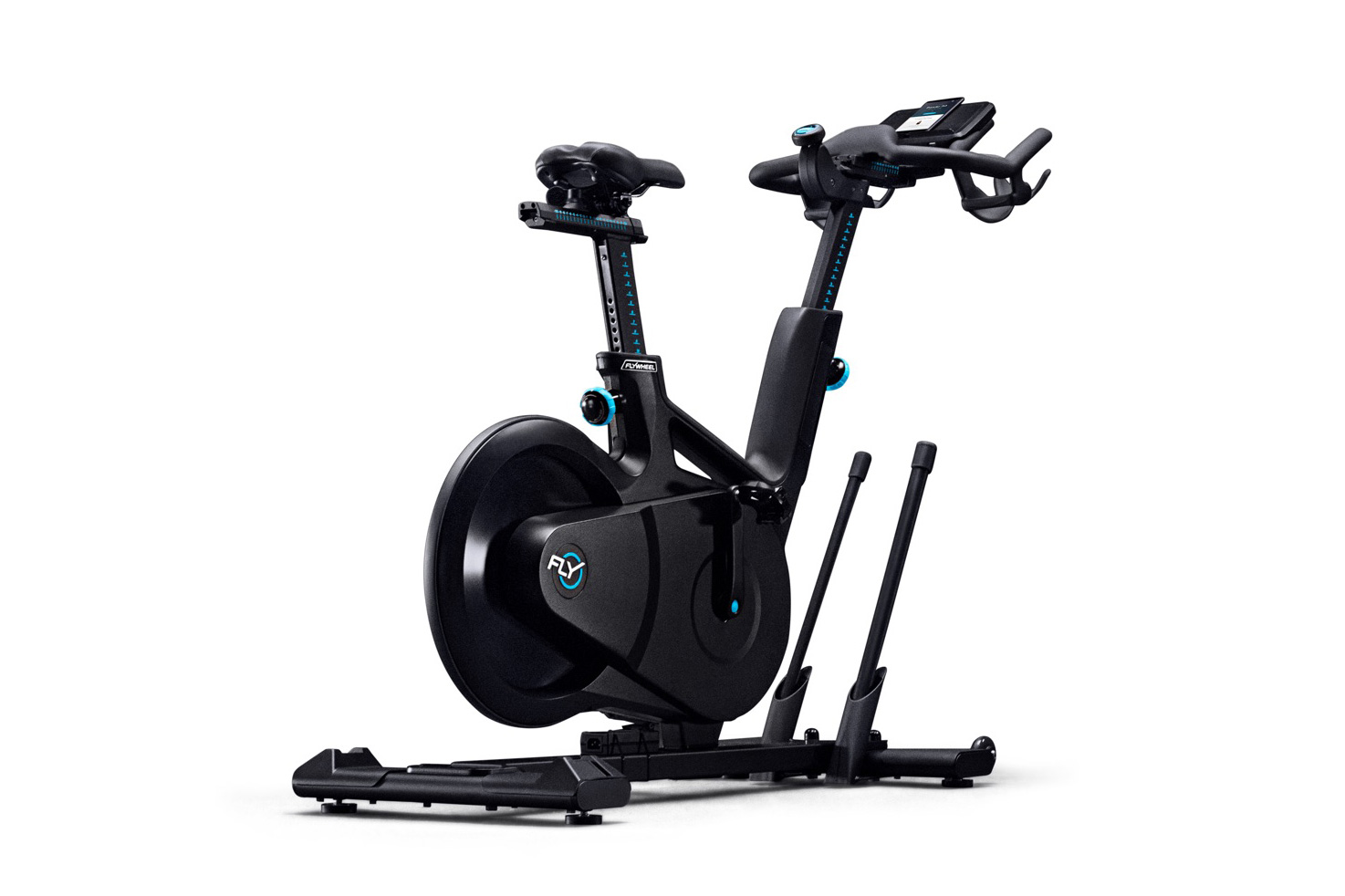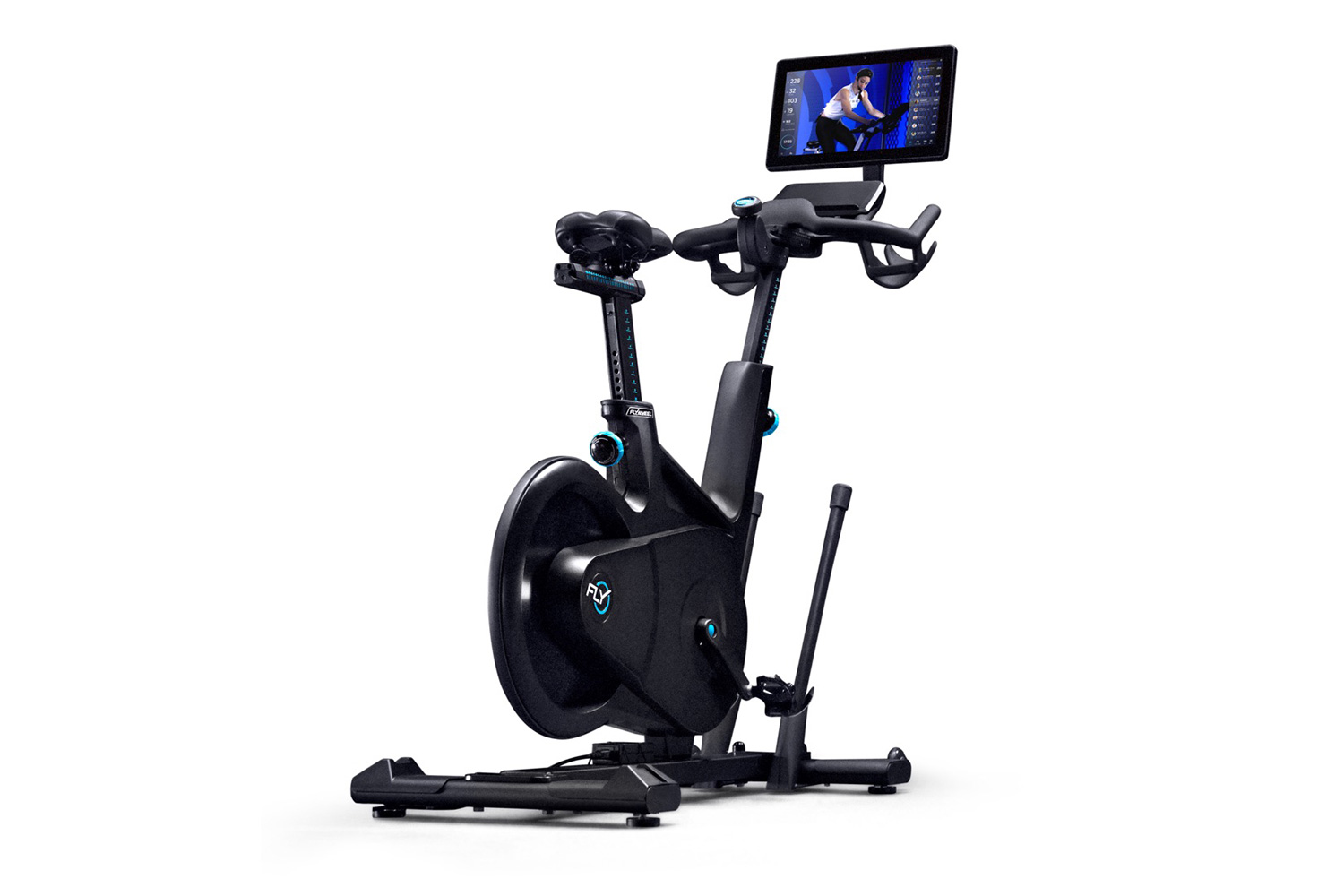There’s no sweat like spin sweat. Hot yoga, mountain climbing, pounding the pavement through rain and blistering heat? Sure, these things make us perspire but not as much as 45 minutes in a spin studio on a stationary bike, an instructor egging you on, your performance on a 100-inch screen for the world to see, the music pounding around you and through your head and chest.
THAT’s spin sweat, and it’s addictive. It turned Flywheel Sports from a passion project to an institution employing 1,200 people in 42 studios across the United States — and good news! Sweat is coming to your living room.
On Wednesday, Flywheel is launching Fly Anywhere, a living-room-friendly version of its studio biking experience based around a new at-home bike and a streaming content platform with live rides filmed at a special studio in New York’s Lincoln Center. And technology makes the whole sweaty thing possible, explained Sarah Robb O’Hagan, CEO of Flywheel Sports.
“It all started with the technical ability, the realization of the potential to have really high-quality streaming content,” she told Digital Trends. “Look at the explosion of streaming workout apps and how that whole market is increasing. Finally, we have the ability to take our experience from the studio into the home.”
The centerpiece of that experience is a new bike that resembles the studio version you might be familiar with, if it were dipped in black wax and left to drip dry. The matte black carbon-fiber frame is smooth and light at around 100 pounds, with neon-blue design elements that make it look like something from Tron (though not as much as the hubless, glowing Cyclotron). Studio bikes are belt- and chain-driven; the Fly Anywhere bike is pure belt drive for a quieter ride and it includes Bluetooth and USB, plus support for AppleTV (and soon Roku, Chromecast, and Android devices).
“We were the first cycling company to bring technology into the experience.”
Flywheel plans to sell two versions of the bike: A model without a built-in monitor for $1,699 and one with an attached tablet at $2,099. The monthly subscription costs $39. The tablet screen displays stats and serves as the interface to the your class and your performance, but it’s the AppleTV support that makes this experience shine. Hook up in front of your big screen TV and you’ll be able to join live classes broadcast in 1080p so real you’ll be able to taste the funk from the rest of the class.
“On the big screen, tricked out with speakers? It’s like pimp my gym,” she joked. But keep in mind, cameras aren’t going to be in every studio. “That wouldn’t be a particularly good at home experience,” O’Hagan points out. “It would feel like you were watching a security camera.”
Instead, think of Fly Anywhere as a separate experience, and the company put a lot of time into getting the right angles. HD requires special thinking. If you like your usual instructor, you can keep them; you just can’t join their class remotely.
It’s all about data — meet the athletic intelligence engine
If you’re unfamiliar with Flywheel, you might be unaware of the company’s passion for data and technology. In class, a small computer is attached to each bike around hip level; glance down at it for real-time stats like energy output, speed, tension on the wheel, and so on. Bikes are arrayed on levels like in an auditorium, facing an instructor and the signature feature of the class: a giant TV screen called the TorqBoard, which aggregates data from the bikes and shows you how you’re performing against your colleagues. It’s a key fact distinguishing Flywheel from SoulCycle, and it’s why you sweat: Faster_than_you23 is beating me? No way in hell. The at-home experience builds directly on that.

“You’re going to be able to compare your stats to everyone else in the Flywheel community. You’re going to be able to compete in challenges that involve in-studio and at-home,” O’Hagan said.
Consider the Fitbit conundrum: I walked 6,000 steps but what does it mean? How does that help me lose 5 pounds or reduce my cholesterol or train for a marathon? The simple data aggregation of competition makes classes actionable and may take away that niggling concern about who’s accessing your personal data. Beyond that, Flywheel built an AI engine called the Athletic Intelligence Engine to assess your goals, help you pick the right classes and music, and, in general, enjoy the experience more.
“It’s an algorithm behind the content it’s serving to you. It is an engine that is learning with you and is going to get smarter as you go … and when you are in our studios, it’s going to know what you’re doing, so it’s like bringing both sides [of our business] together.”
A new business model
But is Flywheel biting off more than it can chew? When Amazon first announced plans to move from being a bookstore to making consumer electronics devices like the Kindle, industry analysts were skeptical. CE devices have razor-thin margins, after all, and brand names are usually what help sell products. Sony, Samsung, Apple, Dell — these are electronics makers. Amazon’s success in the space proves how readily companies can grow into new fields, despite those initial questions.
“On the big screen, tricked out with speakers? It’s like pimp my gym.”
“The blurring of lines between company competencies has sped up in the last five to ten years, and the barriers to creating new experiences have definitely come down,” she said. Just look at Kickstarter and Indiegogo, which have enabled hundreds of people with ideas to realize their dreams. Besides, Flywheel already had expertise in the hardware side of things.
“It really is taking a lot of what we were already doing and building on it. But the software development, the streaming, and all that bit is obviously completely new.” It’s an enormous undertaking for the company, but one O’Hagan feels is a natural for Flywheel.
“What we’re offering, in this price range, with what it comes with, is extraordinarily competitive,” she points out. “We were the first cycling company to bring technology into the experience in the first place. So, you would expect us to keep going to the next level.”




